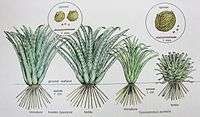Isoetes beestonii
| Isoetes beestonii Temporal range: Late Permian | |
|---|---|
 | |
| Complete plant of Isoetes beestonii from latest Permian Coalcliff Sandstone in South Bulli Colliery, NSW, Australia.[1] | |
| Scientific classification | |
| Kingdom: | Plantae |
| Division: | Lycopodiophyta |
| Class: | Isoetopsida |
| Order: | Isoetales |
| Family: | Isoetaceae |
| Genus: | Isoetes |
| Species: | †I. beestonii |
| Binomial name | |
| †Isoetes beestonii Retallack 1997 | |
Isoetes beestonii is the oldest known species of the living quillwort genus from the latest Permian of New South Wales and Queensland. Originally considered earliest Triassic,[1] it is now known to be latest Permian in age, immediately after the Permian Triassic mass extinction.[2]

Reconstructions of sterile and fertile examples of Isoetes beestonii from the latest Permian Coal Cliff Sandstone of South Bulli Colliery, NSW, and of Tomiostrobus australis from the Early Triassic Gosford Formation near Terrigal, NSW
Description
Isoetes beestonii is preserved as whole plants in life position within bedding planes, and presumably lived as an early successional weed in lake and pond sedimentary environments, like living Isoetes. Its leaves were wider and more succulent than modern spacies of Isoetes.[1] Like modern Isoetes, fertile plants were little different from sterile plants, unlike Early Triassic Tomiostrobus which formed woody conelike fertile plants.
See also
References
This article is issued from Wikipedia - version of the 8/5/2016. The text is available under the Creative Commons Attribution/Share Alike but additional terms may apply for the media files.